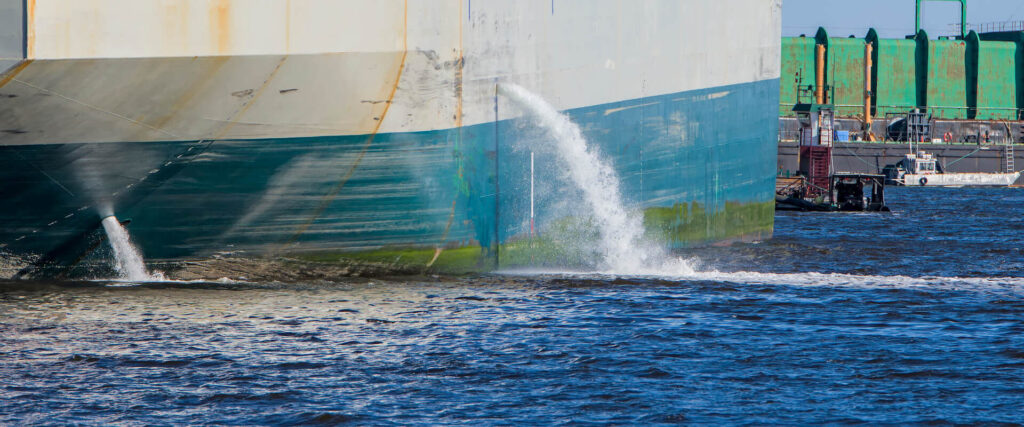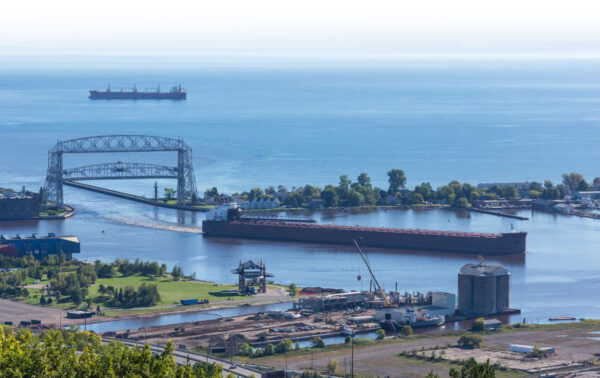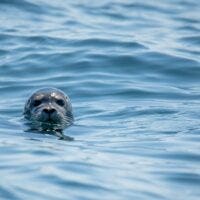Why commercial ships carry ballast water on board, and how it affects the marine environment.
Large cargo ships use ballast water to balance their weight and keep them stable during a voyage. Although it is essential for the safety of the ship, ballast water can be harmful to the marine environment as its discharge can release potentially invasive species into a new marine environment. Proper management and treatment of ballast water significantly reduces this risk.
What is ballast water?
Ballast is extra weight added to a ship when it unloads its cargo – without it, the ship would pop out of the water like a cork and could become unstable.
Prior to the 1880s, ships used solid ballast materials such as rocks and sand, which people had to shovel into and out of cargo holds. If not properly secured, solid ballast could shift in heavy seas, risking capsizing. With the introduction of steel-hulled ships and automatic pumping technologies in the 20th century, water became a safer ballast material for ships.
When ships need ballast, water is easily pumped into ballast tanks from the sea or the inland waters where the ship is located, which adds weight to the bottom and sides of the vessel. Ballast water is pumped out into the ocean when it is no longer needed (when the weight of the ship needs to be lightened) – for example, when the ship is taking on cargo. Ballast water can be disposed of on land while ships are at berth; however, this practice is not common as it is costly and requires specialized equipment and complex processes.
Ballast tanks are an integral part of a ship’s design with their number and size varying according to the vessel’s type and construction. Ships can have a range of ballast capabilities and capacities, but generally ballast equates to 25% to 30% of the weight the ship can carry – including cargo, fuel, crew, passengers, food, and water – or its dead weight tonnage.
Why is ballast water important?
Ballast water is crucial for the safe operation of ships. It is used to adjust the distribution and overall weight of the vessel to keep the ship floating upright and in a safe, stable condition. Ballast is used to compensate for different cargo loads that a ship may carry at different times, including changes in weight during loading and unloading. It also provides stability and manoeuvrability during a ship’s voyage.
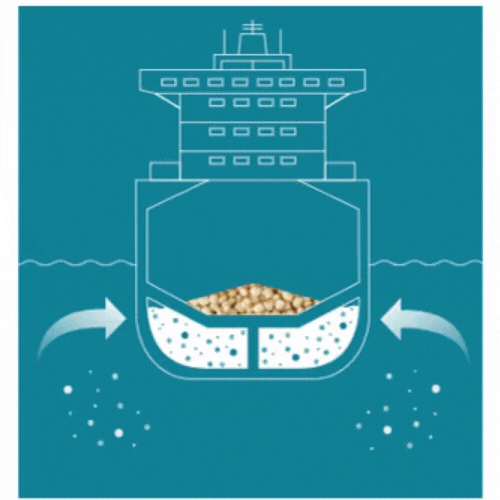
A commercial ship ballasting and de-ballasting to balance its cargo load
Ballasting – the process by which a commercial vessel pumps water in or out its ballast tanks while in transit or at a port – is essential for safety, especially if the ship is carrying a heavy load in one hold and a lighter load in another, or empty and facing rough seas. Ballasting is not to be confused with “bunkering” – the process by which a ship’s fuel tanks (called bunker tanks) are filled with the marine fuel (called bunker fuel) needed for the voyage.
Why is ballast water an issue?
Loading and unloading untreated ballast water can pose a major threat to the environment, public health and the economy as ships become a carrier for the transfer and spread of threatening invasive aquatic species, from one part of the world’s oceans to another.
When ballast water is pumped into a ship, sediment and microscopic organisms are also transferred into the ballast tanks. These organisms include bacteria, microbes, small invertebrates, eggs, cysts, and larvae of various species. Many of these organisms are able to survive for extended periods in inhospitable environments, including a ship’s ballast tanks. When the ballast water is discharged, the organisms are released into the local marine environment. Without their natural predators and given the right conditions these foreign species will not only survive but can also flourish, becoming invasive and threatening and even eliminating resident populations.
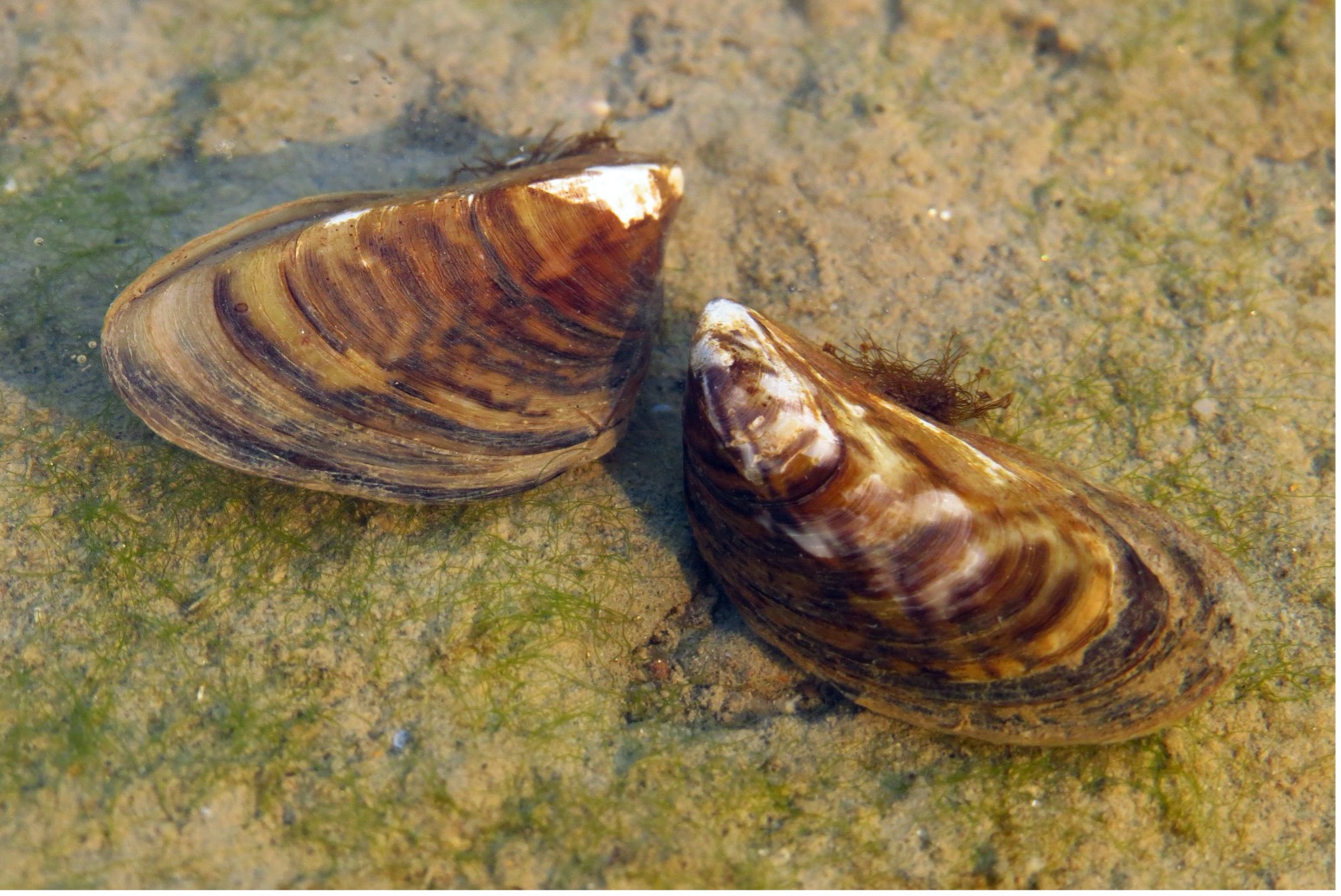
Zebra Mussels, native to the Black and Caspian Seas are invasive to some of Canada’s lakes and rivers
The zebra mussels’ invasion of the Great Lakes is one example of the devastation a species can cause when introduced to a new marine environment. Since its arrival in the late 1980s due to ship ballast water discharge, this freshwater mussel, native to the Black and Caspian Seas in Europe, has caused significant environmental damages, including disrupting the local food chain. Because they reproduce quickly and in large numbers – it is estimated that females can lay as many as one million eggs per year – zebra mussels rapidly overwhelm local species such as native mussels, feeding on the same food sources and hampering native species’ growth and development. Zebra mussels can also attach to and suffocate native mussels, causing them to die. Over the years, zebra mussels have continued to spread in Canadian waters and have been found in Quebec (St. Lawrence River) and Manitoba (Lake Winnipeg). This invader has also cost billions of dollars for cleaning and repairs to underwater infrastructure, for example clearing clogged outflow pipes and clusters on pilings.
On the economic front, the impact of invasive species is considerable. In Canada alone, it is estimated that invasive aquatic species cause close to $6 billion in disruption and damages every year.1 These include increasing the proliferation of toxic algae, clogging water intakes and pipes for power and water treatment plants, and damaging watercraft and docks.
Ships’ ballast water is one of the main causes of the transfer of invasive aquatic species worldwide, explaining why it has become an important issue over the past decades. The spread of invasive species is now recognized as one of the greatest threats to the ecological and the economic well-being of the planet as the damage caused is often irreversible.2 For example, the European Green Crab – one of the world’s most unwanted invasive species – was first introduced by ship to eastern Canada in the 1950s and, more recently, to the west coast of Vancouver Island in British Columbia. It is a formidable predator that out-competes native crabs for food and disrupts essential eelgrass beds and the crustaceans, molluscs, and fish they shelter. Because they compromise the overall balance of the coastal ecosystems and reduce the abundance of native species, European Green Crabs threaten local fisheries and aquacultures and the people that depend on them.3 It has been found to threaten salmon including the food, ceremonial, and social fisheries of Indigenous communities. Although the population of European Green Crab is closely monitored and controlled in Canadian waters, this invasive species can cause critical damage to the marine environment in which it thrives.

European Green Crab found in Canada’s eastern and western waters
Facts and figures about ballast water and invasive species:4
- Approximately 10 billion tonnes of ballast water are transported worldwide every year, which could fill about 4 million Olympic-sized swimming pools
- An estimated 7,000 aquatic species are transferred in ballast water every hour of every day
- One new invasion occurs every 9 weeks
The European Green Crab, round goby, barnacles, and bloody red shrimp are all examples of invasive aquatic species found in Canadian waters. Learn more about the role commercial marine shipping plays in the transfer of invasive species here.
What are the ballast water regulations in place in Canada?
To prevent ecological and environmental damage resulting from the discharge of ballast water, in 2006 Canada implemented Ballast Water Control and Management Regulations (now Ballast Water Regulations) under the Canada Shipping Act, 2001.
In 2010, Canada acceded to the International Maritime Organization’s (IMO) International Convention for the Control and Management of Ships’ Ballast Water and Sediments, commonly known as the Ballast Water Management Convention. The Convention, which came into force in September 2017, aims to prevent the spread of harmful aquatic organisms from one region to another, by establishing standards and procedures for the management and control of ships’ ballast water and sediments.
The ballast water management standards under the Convention include:
- D-1: a standard for ballast water exchange that requires ships to exchange their ballast water in open (at least 200 nautical miles from the shore) and deep seas (at least 200 metres deep), away from coastal waters 5
- D-2: a standard that prescribes the maximum number of living organisms allowed to be discharged in ships’ ballast water. Ships must install onboard ballast water management systems to treat the ballast water before it is discharged
- D-3: a standard for the approval of ballast water management systems to be used. In Canada, treatment systems meeting the IMO ballast water management systems code and approved by Transport Canada must be installed onboard commercial ships of 400 gross tonnes or more, such as bulk and car carriers, container ships and oil tankers
Commercial ships of at least 400 gross tonnes built on or after September 8, 2017, must be equipped with a ballast water management system. However, the vessels built before that date must be retrofitted with a ballast water management system by 2024 to meet the Ballast Water Management Convention’s D-2 standard.6
In 2021, Canada adopted new Ballast Water Regulations to replace the previous regulations and impose more stringent requirements on ships while ensuring better compatibility between the Canadian and American ballast water regimes.7 The new regulations apply to Canadian vessels everywhere and foreign vessels operating in Canadian waters that are designed and built to carry ballast water. Under these regulations, ships are required to:
- Develop and implement a ballast water management plan
- Obtain a certificate attesting that their ballast management plan meets the Convention’s requirements
- Keep records of ballast water regulations and be subject to inspections to verify compliance with the regulations
- Comply with a performance standard (D-2 of the Convention) to limit organisms discharged by 2024
Failure to comply with these regulations is subject to monetary penalties that can range from $600 to $25,000, depending on the violation. The new regulations allow smaller vessels – less than 50 m in length and 3,000 gross tonnes, that are not self-propelled – operating in Canadian waters and the high seas the option of adopting an equivalent compliance approach tailored to their operations rather than installing a ballast water management system.8 More information on the new Ballast Water Regulations is available here.
What is a ballast water management plan?
The ballast water management plan is an operational tool ship operators must develop, implement, and keep on board to meet the Ballast Water Management Convention’s requirements. It outlines the actions to take and the procedures to follow by the ship’s crew to ensure the safe management of ballast water. The plan addresses the following:
- What are the duties of the crew in carrying out ballast operations
- How to conduct ballasting operations
- Where are locations for ballast water exchange
- What are the rules for different port state controls worldwide
- Which ports provide shore discharge facilities for sediments and ballast water
The plan also requires record-keeping – ballast water exchange record book – in which information such as the date and the amount of ballast water exchanged, the salinity and temperature of the ballast water, and the location of the ship, is recorded.
What are ballast water management systems?
Ballast water management systems eliminate the organisms that can be found in ships’ ballast water. These systems use or combine different technologies – filters, chemicals, light, ultrasound, heat, electricity, magnetic fields – depending on the type of ships, the space available onboard, and cost. Ballast water is generally treated in a two-stage process through which the solid particles in the water are first separated before the water is treated using one or more technologies to destroy potentially harmful marine organisms in the water or sediments.
Why is the requirement for ballast water management systems onboard ships causing controversy in the Great Lakes and
St. Lawrence region?
Canadian ship operators have raised concerns over the use of ballast water management systems in the Great Lakes and St. Lawrence River. Both the effectiveness of the systems to treat freshwater to the level required by the Convention’s standard and the practicality, in terms of time and cost, are being questioned. Retrofitting a ship to install a ballast water treatment system can take several months and cost up to $3.5 million,9 a significant impact to ship owners and operators’ budgets.
However, most of the controversy is due to Canada and the United States disagreeing on the requirement for ballast water management systems onboard ships in the Great Lakes. Unlike Canada, the U.S. has not ratified the Ballast Water Management Convention, and although it has implemented most of its provisions, it does not require its domestic fleet operating in the Great Lakes to install ballast water management systems. This decision is based on the premise that current systems are not well suited for the region’s unique environment and add additional costs for ship operators.
With the U.S. fleet of commercial vessels operating on the Great Lakes exempted from having to install and operate costly ballast water management systems, both the freshwater ecosystem and the competitiveness of Canadian ship operators’ is at risk. The countries are currently negotiating a resolution.
In light of Canada’s new Ballast Water Regulations, vessels operating in the Great Lakes built in or after 2009 will have until 2024 to comply with the performance standard and install a ballast water management system on board, while vessels built before 2009 will have until 2030 to come into compliance. American vessels operating in the Great Lakes will be exempt from having to install and use a ballast water management system as long as they don’t load or unload ballast water while transiting in Canadian waters.
Indigenous views:
Aquatic invasive species introduced through ships’ ballast water can have significant impacts on Indigenous communities across Canada. Healthy and balanced ecosystems are crucial for all living things. By competing with local marine life for resources, invasive species can jeopardize the health and population size of native species. Once an invasive species is introduced to a new area, it can be difficult to control and impossible to eradicate, causing irreparable harm to the local ecosystem. The disruptions invasive species cause in the marine environment can compromise its sustainability and that of the Indigenous communities who rely on it – including local seafood – to thrive and survive.
Invasive species can threaten the Indigenous way of living as Indigenous Peoples share a deep connection with nature, its biodiversity, wildlife, and waters. They have a long and historic relationship with the land that feeds them, treating it with care and respect. Many communities still harvest their food and medicine from the land. When invasive species disrupt the availability of native fish and shellfish they threaten the viability of local food sources and fisheries, which causes a significant impact in these communities.
As stewards of the land and water, Indigenous communities work to support the health of their environment and the many species it sustains. That includes protecting food sources and medicinal plants. Managing invasive species – and building capacity to do so within the communities – is an important pillar of Indigenous stewardship. Learn more about the role Indigenous communities can play in invasive species management in this toolkit developed by the Invasive Species Council of BC, in partnership with the Indigenous Invasive Species Network and Indigenous Services Canada.
Learn more
Invasive Species and Marine Shipping
The Canadian Ballast Water Program
The Ballast Water Management Convention
Indigenous Community Toolkit for Managing Invasive Species
#clearfacts #sustainableshipping #invasivespecies
References
1 Fisheries and Oceans Canada. (2018). A Canadian Action Plan to Address the Threat of Aquatic Invasive Species.
2 Canadian Science Advisory Secretariat. (2014). National Risk Assessment for Introduction of Aquatic Nonindigenous Species to Canada by Ballast Water. Fisheries and Oceans Canada for Transport Canada.
3 Government of Canada. (2021). European Green Crab.
4 International Maritime Organization. (2019). Ballast water management – the control of harmful invasive species.
5 International Maritime Organization. (2019). Implementing the Ballast Water Management Convention – What are the ballast water management standards?
6 Regulation D-2 Ballast Water Performance Standard – Ships conducting ballast water management shall discharge less than 10 viable organisms per cubic metre greater than or equal to 50 micrometres in minimum dimension and less than 10 viable organisms per milliliter less than 50 micrometres in minimum dimension and greater than or equal to 10 micrometres in minimum dimension; and discharge of the indicator microbes shall not exceed the specified concentrations.
7 Government of Canada. (2019). Canada Gazette, Part II, Volume 155, Number 13: Ballast Water Regulations.
8 Government of Canada. (2019). Canada Gazette, Part II, Volume 155, Number 13: Ballast Water Regulations.
9 DNV Maritime Impact. (2019). Type-Approved, USCG-Compliant Ballast Water Treatment Systems Now Widely Available.
